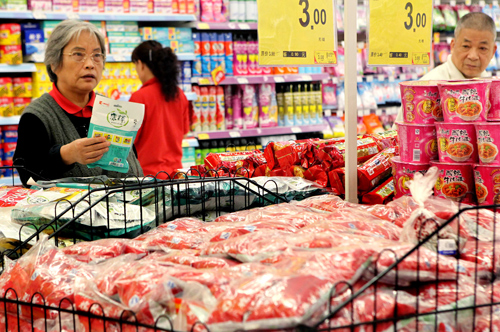|
 |
|
PRICE CHECK: Consumers check prices at a super market in east China's city of Shanghai on October 14, 2011. China's CPI grew 5.5 percent in the first 11 months, 1.5 percent higher than scheduled (XINHUA) |
Price control
Target: Keep the CPI around 4 percent, maintain stability in the real estate market, and meet the needs of residents' reasonable housing demands.
Year-end performance: China's CPI grew 5.5 percent over the first 11 months. However, the year-on-year rate of increase declined in November, to only 4.2 percent, 0.2 percent less than in October. Housing prices decreased in four out of 70 large- and medium-sized cities, and 61 cities saw prices rise by less than 5 percent during the first 11 months.
Analysis: To ease rising commodity prices, the Central Government has made great efforts to tighten liquidity, increase supply and reduce intermediate links. "The government adjustment has resulted in a significant decline in the rate of CPI growth at the end of the year, indicating that the government's efforts to control inflation have basically reached expectations," said Xiao Yaofei, Deputy Director of the International Economic and Trade Research Center of the Guangdong University of Foreign Studies.
"Inflationary pressure will still exist next year, influenced by some uncertain factors in China and the world," said Yu Nanping, research fellow at the School of Advanced International and Areas Studies affiliated with East China Normal University. "China is in a period of social transformation and imbued with many contradictions, making commodity prices--crucial to the people's livelihood--at the center of the government's agenda," said Yu.
Insurance
Target: Accelerate improvement of the social security system for both urban and rural residents. Pilot programs for the system of old-age insurance for rural residents need to be expanded to 40 percent of counties nationwide, from 10 percent in 2009. Subsidies for medical insurance for urban residents and residents under the new type of rural cooperative medical care will be increased to 200 yuan ($31.6) from 120 yuan ($18.96) per capita annually.
Year-end performance: By the end of December, more than 302 million urban and rural residents have subscribed to basic medical insurance, and the number of regular pensioners hit 79.66 million. By 2012, the government is accelerating plans to put the entire population of the country under pension and medical insurance systems, eight years ahead of previous estimates.
China further boosted healthcare reform. Medical insurance covers over 90 percent of urban workers and non-workers residents, and rural residents under the new type of rural cooperative medical care system.
Analysis: "Even though social insurance is gradually covering all areas in China, rural residents' insurance level is lower than needed," said Wang Wenzhang, a professor at Peking University. There is a great income difference between pensioners from institutions and enterprises. "The country should promote equalization of insurance in China," Wang said.
| 